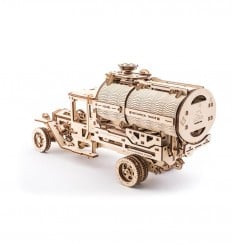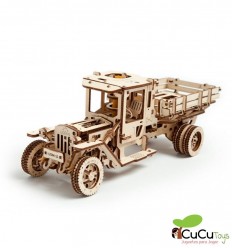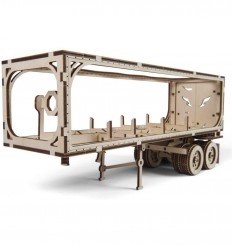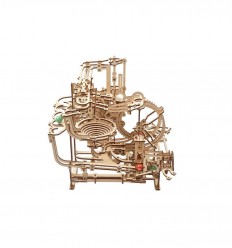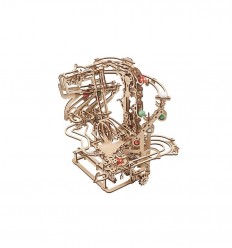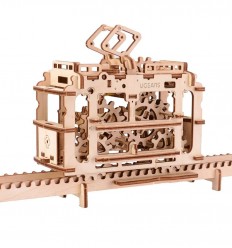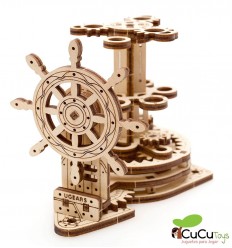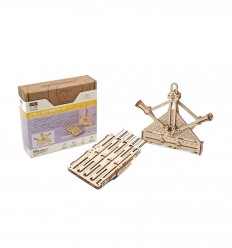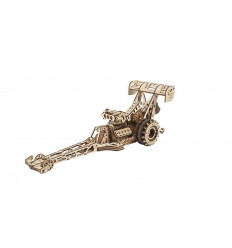No products
Prices are tax included

Wooden Mechanical Models
-
-
-
UGears - UGM-11 Truck, 3D mechanical model
CCT21UG70015Esta bella e intrincada maqueta reúne y supera, todas las innovaciones técnicas y artísticas que los modelistas han sabido apreciar en las maquetas de Ugears. Repleta de detalles realistas para dotarla de un mayor atractivo, esta versión del símbolo de la tecnología y aventura del siglo XIX cautiva la...
84,90 € -
-
UGears -Marble run Stepped hoist
CCT21UG70157Número de piezas: 355.Dificultad: AvanzadoTiempo de montaje: 8 horas.Edad recomendada: 14 años.Dimensiones interiores de la caja: 37,8 x 17 x 3,5 cm.Dimensiones del modelo: 29,5 x 27 x 27,5 cm.
52,90 € -
UGears -Marble run Chain hoist
CCT21UG70156Número de piezas: 400.Dificultad: AvanzadoTiempo de montaje: 7 horas.Edad recomendada: 14 años.Dimensiones interiores de la caja: 37,8 x 17 x 3,5 cm.Dimensiones del modelo: 27,5 x 30,5 x 27 cm.
52,90 € -
UGears - Marble run Spiral hoist
CCT21UG70177The Spiral Elevator Marble Race is the fourth model in the fascinating Ugears series of mechanical wooden marble races. The elevator has two types of track to speed up the climb: the main elevator, which is spiral and the vertical elevator. Turn the crank to raise the coloured marbles into the accumulator for three marbles at the top (each marble rises...
54,90 € -
UGears - Flying Ford Anglia - Harry Potter
CCT21UG70173The Anglia is a faithful reproduction of the Weasley's Muggle Weasley's spellbinding Muggle car. The little ones will love flying it through the air or trying to race it along the tracks, right in front of the Hogwarts Express. Who doesn't remember the scene in "Harry Potter and the Chamber of Secrets", where Harry and Ron are flying back to Hogwarts in...
54,90 € -
UGears - ArchBallista Tower, 3D mechanical model
CCT21UG70048This new UGears creation consists of two separate pieces: the Archballista and the Tower, both, fully functionable and movable. The Archballista is made of two modules: the base, that provides a stable support for a unit, and a firing component, that actually shoots wooden bolts, up to four bolts in a round. Number of parts: 292Difficulty level:...
39,90 € -
UGears -Mechanical Aquarium, wooden 3D kit
CCT21UG70155Ugears brings us this time an ingenious aquarium of tropical fishes that circle endlessly chasing each other among the algae where a small seahorse lives. Marine aquarism has that appeal that makes it one of the world's most popular hobbies. Maybe you have been scuba diving or snorkelling near the beach, and you want to remember those beautiful images...
54,90 € -
-
UGears - Tram on rails, 3D mechanical model
CCT21UG70008The electric tram is one of the oldest means of urban transport, and at the same time less polluting than our current cars. This model is inspired by the first trams and funiculars in history and is perhaps the most romantic model in our catalogue. With a decidedly retro style, the tram can run on the adjustable tracks that are part of the model....
39,90 € -
-
UGears - 460 Steam Locomotive, 3D mechanical model
CCT21UG70012Esta bella e intrincada maqueta reúne y supera, todas las innovaciones técnicas y artísticas que los modelistas han sabido apreciar en las maquetas de Ugears. Repleta de detalles realistas para dotarla de un mayor atractivo, esta versión del símbolo de la tecnología y aventura del siglo XIX cautiva la...
84,90 € -
UGears - STEM Lab Counter, 3D wooden kit
CCT21UG70130This Counter does what its name implies: it counts repetitive actions. To do this, it has a Maltese cross and three gears fixed to wheels, with the numbers 0 to 9.This model will allow you to observe an interesting mechanical feature: the conversion of the linear movement of the button, linked to the mechanism of the Geneva drive into the rotary movement...
25,90 € -
-
UGears - STEM Lab Differential, 3D wooden kit
CCT21UG70132The UGears differential is the perfect example of a common part in the transmission of cars, which is responsible for the maneuverability and behavior of them. This differential was invented in 1825 by a Frenchman, Onésiphore Pecqueur, and was significantly improved by a German automotive engineer, Ferdinand Porsche, in the 1930s.Number of pieces:...
25,90 € -
UGears - STEM Lab Arithmetic set, 3D wooden kit
CCT21UG70152The Mechanical Addiator is a compact calculator (or adding machine) that works by moving its rails with the help of the punch included in the kit. By moving the rails, which are marked with arrows and the digits 0 to 9, you can perform addition and subtraction operations.The mechanical multiplier is a flat tilting mechanism that performs binary operations...
25,90 € -
-
UGears - Foldable phone holder, 3D mechanical model
CCT21UG70145Following the trend of minimalist and functional design, Ugears is proud to present a cool and handy addition to its collection of mechanical wooden models: the Mini Series Foldable Phone Holder.Number of pieces: 73Difficulty: Easy.Assembly time: 2 hours.Recommended age: 8+ years.Model size: 12.2 x 6.5 x 11.7 cm.Blister pack size: 9.2 x 21 x 1,5 cm.
12,90 € -
UGears - Top Fuel Dragster
CCT21UG70174Dragsters are the undisputed kings of the drag strip. Capable of accelerating from 0 to 160 km/h in less than a second with a g-force of 5 on start-up and top speeds of 540 km/h, dragsters are the automotive embodiment of technology, power and speed. With their long dragonfly-like bodies, fiery exhaust trails, long fins and parachute-like throttles, these...
54,90 € -
UGears - Mechanical Celesta
CCT21UG70178Do re, mi, fa, sol, sol, sol, la, si, do. As Julie Andrews said in The Sound of Music: "Once you get the notes in your head, you can sing a million songs just by mixing them together". Ugears introduces us to the second DIY musical instrument. The Celesta Mecanica is both a mechanical wooden model and a real musical instrument, just like the hurdy-gurdy....
89,90 € -
UGears - STEM Lab Tachometer, 3D wooden kit
CCT21UG70153I'm sure you've been asked in the car: "Mummy mummy, how fast do you have to change gears?A tachometer (also known as a revolution counter) is a device that measures the rotational speed of different parts in engines or other mechanisms. Its measurements are made in revolutions per minute (RPM). The tachometer also measures and monitors the load limits to...
25,90 € -
UGears - STEM Lab Variator, 3D wooden kit
CCT21UG70147Did you know that cars have a very important component called Variomatic? It's a mechanism that helps the car move at different speeds and adapt to different situations on the road.The Variomatic is like a kind of 'brain' of the car, which adjusts the power and speed of the engine so that you can drive the car safely. The Variomatic can be adjusted in...
25,90 €
- 1
- 2
Wooden Mechanical Models - UGEARS
This is UGears, designs inspired by real engineering and imitating it in models that will captivate the whole family.
Laser-cut wood boards for greater precision. This type of material is perfect for family projects through STEM (Science, Technology, Engineering and Math) learning.
The designs are inspired by real mechanisms and teach your love of art and ingenuity. Building these beautiful models is, most of all, a joyful experience.
The meticulous testing and quality control of these products has only one goal: to provide a captivating and rewarding experience for the entire family.




